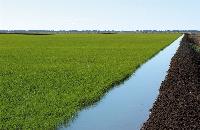
Overview
There are around 2,000 family operated farm businesses growing rice in the Murrumbidgee valleys of NSW and the Murray valleys of NSW and Victoria. In NSW all growers are shareholders of Ricegrowers Limited which is the company responsible for production and marketing of rice and rice based food in Australia and Internationally. The average size of an Australian rice farm is around 400 hectares.
Rice growing is entirely dependent on water for irrigation being made available. When there is low or zero water availability, there is no rice grown. Rice can only be grown on approved soils and is regulated by the rice water use policies of the various irrigation corporations (Murrumbidgee Irrigation Limited, Murray Irrigation Limited and Coleambally Irrigation Cooperative Limited). The Australian rice industry leads the world in water use efficiency. From paddock to plate, Australian grown rice uses 50% less water than the global average. Water use per hectare continues to decline because of the industry's commitment to developing high yielding rice varieties that use less water, and the use of world's best management practices.
Eighty per cent of rice produced in Australia is of medium grain Japonica varieties. These are commonly known as temperate varieties – grown throughout the world in climates similar to Australia. These climates reach high summer temperatures without the humidity of tropical climates and are well suited to Japonica varieties.
The remainder of rice grown in Australia is long grain Indica type varieties, including fragrant rice. Amaroo and Millin are the most popular medium grain varieties and Langi is the largest selling long grain. Australia also produces shorter grain varieties, such as Koshihikari specifically for the Japanese market.
NSW rice marketing arrangements
The Rice Marketing Board of NSW (the Board) was established on 9 November 1928 under the Marketing of Primary Products Act, 1927. All export paddy rice in NSW is divested from producers and becomes the property of the Board. The Board’s primary function is to obtain the best possible return for rice growers consistent with the maintenance of orderly trade.
The Board appointed the grower-owned rice miller and marketer Ricegrowers Cooperative Limited (trading as SunRice) as its authorised buyer and agent on 1 February 1986 under the provisions of the Marketing of Primary Products Act. This makes RCL the Sole and Exclusive Export Licence holder. Through the agency agreement with the Board, RCL receives, stores, processes and markets 99 per cent of Australian rice production. RCL exports about 85 per cent of rice to more than 70 destinations, while the domestic market receives the remaining 15 per cent.
The domestic rice market operates under an “authorised buyer scheme” whereby the Board approves parties wanting to buy and sell rice domestically as “authorised buyers”.
